Cancer sores on dogs can be one of the most visible and concerning signs that Golden Retriever owners encounter. Unlike internal cancers that may remain hidden for months, skin-related cancers often present as noticeable changes that alert owners to potential health issues early in the disease process.
Golden Retrievers face particular vulnerability to certain types of skin cancers, making it crucial for owners to understand what cancer sores on dogs look like, how they develop, and when immediate veterinary attention is necessary. This comprehensive guide will equip you with the knowledge needed to protect your Golden Retriever’s skin health and recognize warning signs before they become serious problems.
Understanding these skin changes isn’t just about identifying cancer, it’s about ensuring your Golden Retriever receives prompt, appropriate care that can make the difference between successful treatment and a more challenging prognosis.
Contents
- 1 Understanding Skin Cancer in Golden Retrievers
- 2 Identifying Cancer Sores on Dogs: Visual Characteristics
- 3 Common Types of Cancer Sores in Golden Retrievers
- 4 Location-Specific Cancer Sores
- 5 Symptoms Accompanying Cancer Sores
- 6 When Cancer Sores Require Immediate Attention
- 7 Diagnostic Process for Cancer Sores
- 8 Treatment Approaches for Cancer Sores
- 9 Prevention and Risk Reduction
- 10 Living with a Golden Retriever with Skin Cancer
- 10.1 Quality of Life Considerations
- 10.2 Long-term Management
- 10.3 What do cancer sores on dogs typically look like?
- 10.4 How quickly do cancer sores develop on dogs?
- 10.5 Can cancer sores on dogs be prevented?
- 10.6 Are cancer sores painful for Golden Retrievers?
- 10.7 How are cancer sores on dogs diagnosed?
- 10.8 What is the prognosis for dogs with skin cancer?
- 10.9 Should I be concerned about every sore on my Golden Retriever?
- 10.10 Can cancer sores spread to other parts of my dog’s body?
- 11 Final Thoughts
Understanding Skin Cancer in Golden Retrievers
Golden Retrievers are among the breeds most susceptible to skin-related cancers, with their light-colored coat and genetic predisposition creating increased risk factors. Cancer sores on dogs in this breed commonly include mast cell tumors, squamous cell carcinomas, melanomas, and various other malignant skin conditions.
The skin serves as the body’s largest organ and first line of defense against environmental threats. When cancerous changes occur, they often manifest as visible alterations that observant owners can detect during regular grooming sessions or daily interactions with their pets.
Several factors contribute to skin cancer development in Golden Retrievers, including genetics, sun exposure, age, and environmental toxins. Understanding these risk factors helps owners take preventive measures while remaining vigilant for early warning signs.
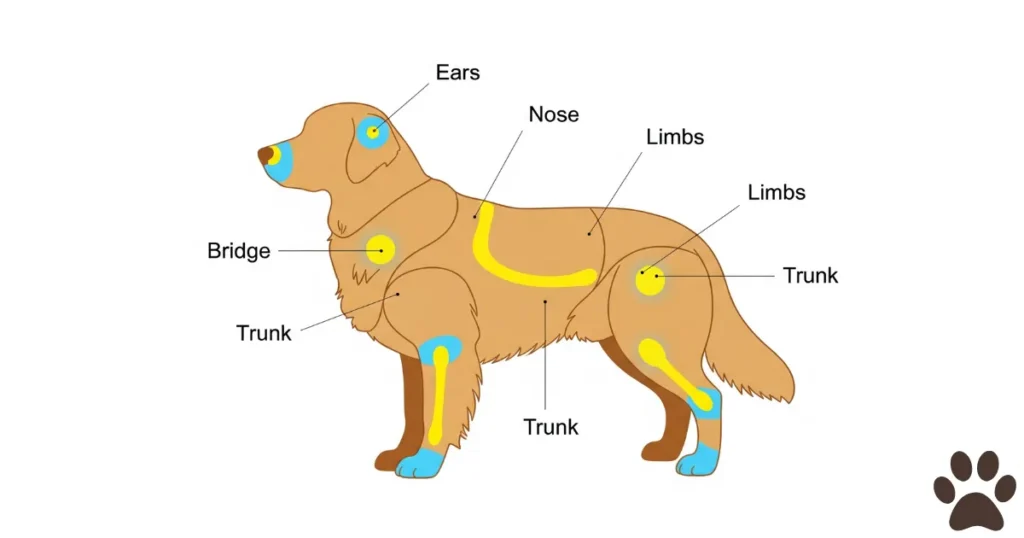
Identifying Cancer Sores on Dogs: Visual Characteristics
Appearance and Texture Changes
Cancer sores on dogs can present in various forms, making visual identification both important and challenging for Golden Retriever owners. These sores may appear as raised bumps, flat discolored patches, ulcerated areas, or irregular growths that don’t heal normally.
Cancerous sores often exhibit several distinctive characteristics:
- Irregular shapes with uneven borders
- Color variations within a single lesion
- Surfaces that may be smooth, rough, or ulcerated
- Persistent bleeding or discharge
- Rapid size changes over days or weeks
Unlike benign skin conditions, cancer sores on dogs typically don’t respond to basic first aid measures and may worsen despite treatment attempts. They may also feel different to the touch– sometimes harder, softer, or more firmly attached to underlying tissues than normal skin.
Size and Growth Patterns
The size of cancerous sores can vary dramatically, from tiny spots barely visible through your Golden Retriever’s coat to large, obvious masses that are immediately concerning. What makes these sores particularly worrisome is their growth pattern rather than their initial size.
Cancer sores on dogs often display concerning growth characteristics:
- Rapid expansion over short periods
- Irregular growth patterns that create asymmetrical shapes
- Development of satellite lesions around the original sore
- Changes in elevation, becoming more raised or more deeply ulcerated
- Persistence despite attempts at treatment
Common Types of Cancer Sores in Golden Retrievers
Mast Cell Tumors
Mast cell tumors represent one of the most common forms of cancer sores on dogs, particularly affecting Golden Retrievers. These tumors can appear anywhere on the body but are frequently found on the trunk, limbs, and head regions.
These tumors often present as:
- Red, raised bumps that may be itchy
- Sores that change size dramatically, sometimes appearing smaller or larger from day to day
- Lesions that cause surrounding skin irritation
- Areas that may swell when the dog becomes excited or stressed
Mast cell tumors can be particularly tricky because they may initially appear benign, resembling simple skin irritations or insect bites. However, their tendency to change size and cause persistent irritation sets them apart from harmless skin conditions.
Squamous Cell Carcinomas
Squamous cell carcinomas frequently develop in areas with less hair coverage or lighter pigmentation, making Golden Retrievers particularly susceptible. These cancer sores on dogs often appear in sun-exposed areas such as the nose, ear tips, and belly.
Characteristics of squamous cell carcinomas include:
- Crusty, scaly patches that don’t heal
- Ulcerated areas with raised, irregular edges
- Bleeding or oozing from the affected area
- Progressive expansion of the affected region
- Development in areas with previous sun damage
Melanomas
Melanomas in Golden Retrievers can occur anywhere on the body but are particularly concerning when they develop in the mouth, nail beds, or other areas with high blood supply. These cancer sores on dogs can be aggressive and require immediate attention.
Melanoma warning signs include:
- Dark, irregularly shaped spots or masses
- Rapid color changes in existing moles or spots
- Bleeding or ulceration of pigmented areas
- Development of new dark spots, especially in older dogs
- Changes in the texture or elevation of existing pigmented areas
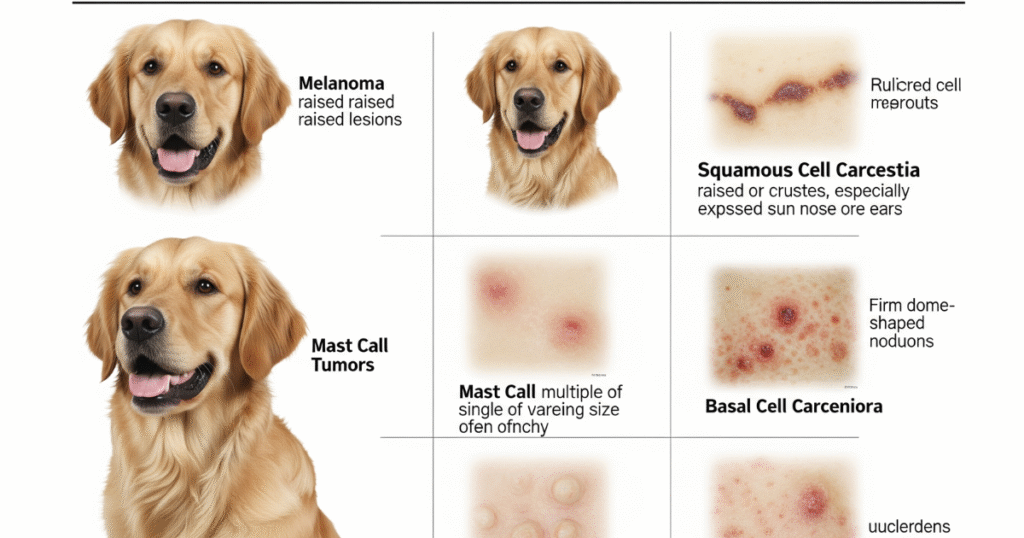
Location-Specific Cancer Sores
Head and Neck Region
The head and neck area of Golden Retrievers commonly develops cancer sores on dogs due to sun exposure and the presence of numerous lymph nodes in this region. Owners should pay particular attention to the ears, nose, lips, and areas around the eyes.
Common presentations in this region include:
- Persistent sores on ear tips that don’t heal
- Crusty or ulcerated areas on the nose
- Unusual growths inside the mouth or on the gums
- Swelling or lumps in the neck area
- Changes in pigmentation around the eyes or lips
Body and Limb Areas
The trunk and limbs of Golden Retrievers can develop various types of cancer sores on dogs, often in areas that are difficult for owners to notice during casual interactions. Regular, thorough examination of these areas is crucial for early detection.
Watch for:
- Sores or masses on the chest or abdomen
- Unusual growths between the toes or on the paw pads
- Lesions along the legs or in the armpit areas
- Changes in the skin around the tail base
- Any persistent sores in areas where the harness or collar sits
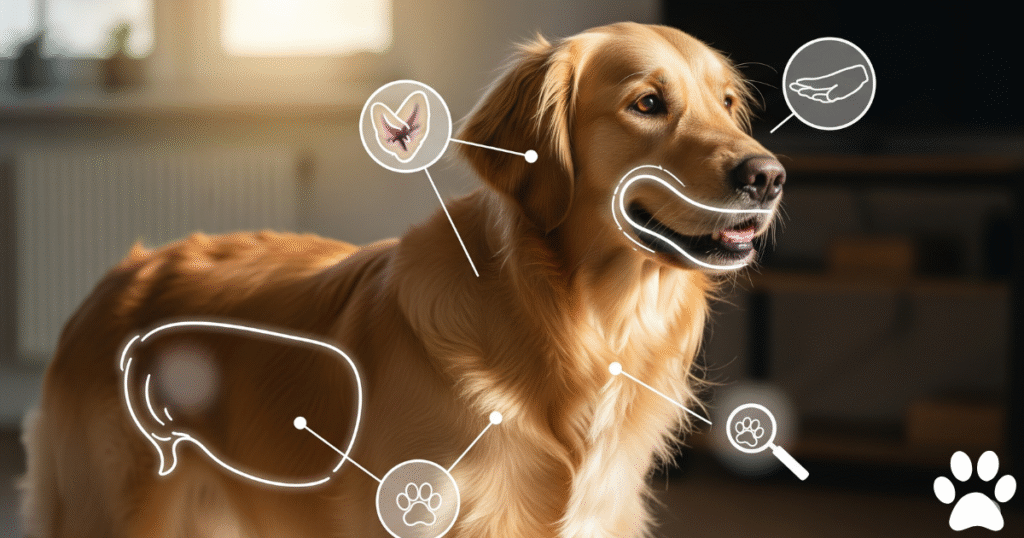
Symptoms Accompanying Cancer Sores
Behavioral Changes
Cancer sores on dogs often come with accompanying symptoms that alert owners to the seriousness of the condition. Golden Retrievers may exhibit behavioral changes that indicate discomfort, pain, or systemic illness related to their skin condition.
Behavioral indicators include:
- Excessive licking, scratching, or chewing at the affected area
- Reluctance to be touched in certain regions
- Changes in activity level or enthusiasm for exercise
- Difficulty sleeping or restlessness
- Decreased appetite or changes in eating habits
Physical Symptoms Beyond the Sore
While the visible sore may be the most obvious sign, cancer sores on dogs can cause additional physical symptoms that indicate the cancer’s impact on your Golden Retriever’s overall health.
Associated symptoms might include:
- Swelling in lymph nodes near the affected area
- Changes in coat quality or hair loss around the sore
- Fever or elevated body temperature
- Unusual odors emanating from the affected area
- General weakness or lethargy
When Cancer Sores Require Immediate Attention
Emergency Warning Signs
Certain characteristics of cancer sores on dogs indicate the need for immediate veterinary care, regardless of the time of day or day of the week. These emergency situations require prompt professional assessment and treatment.
Seek immediate care when:
- The sore is bleeding profusely and won’t stop
- There are signs of severe pain or distress
- The area around the sore shows signs of serious infection
- Your Golden Retriever shows signs of systemic illness
- The sore has grown dramatically in size over 24-48 hours
Progressive Changes That Need Prompt Evaluation
Even when cancer sores on dogs don’t require emergency care, certain progressive changes indicate the need for prompt veterinary evaluation. These changes often signal that the condition is advancing and requires professional intervention.
Schedule appointments promptly for:
- Sores that continue growing despite treatment attempts
- Development of multiple sores in different locations
- Changes in the sore’s appearance, color, or texture
- Persistent discharge or unusual odors
- Any sore that doesn’t show improvement within a week of basic care
Diagnostic Process for Cancer Sores
What to Expect During Veterinary Examination
When you bring your Golden Retriever to the veterinarian for evaluation of cancer sores on dogs, the diagnostic process typically involves several steps designed to determine the nature and extent of the condition.
The examination process usually includes:
- Thorough visual and physical examination of the sore
- Palpation of surrounding areas and lymph nodes
- Photography for documentation and monitoring
- Discussion of the sore’s history and development
- Assessment of your dog’s overall health status
Diagnostic Testing Options
Confirming whether cancer sores on dogs are truly cancerous requires specific diagnostic tests that go beyond visual examination. Your veterinarian may recommend several testing options based on the sore’s characteristics and your Golden Retriever’s overall health.
Common diagnostic procedures include:
- Fine needle aspiration for cellular examination
- Biopsy sampling for definitive diagnosis
- Imaging studies to assess spread or underlying involvement
- Blood work to evaluate overall health status
- Specialized staining techniques for tumor classification

Treatment Approaches for Cancer Sores
Surgical Options
Surgery remains the primary treatment for most cancer sores on dogs, particularly when the cancer is localized and hasn’t spread to other areas. The type and extent of surgery depend on the cancer type, location, and stage.
Surgical approaches may include:
- Complete excision with wide margins
- Reconstructive procedures for large defects
- Lymph node removal if cancer has spread
- Multiple staged procedures for extensive lesions
- Combination with other treatments for comprehensive care
Non-Surgical Treatment Methods
Some cancer sores on dogs may be treated with non-surgical approaches, either as primary treatment or in combination with surgery. These methods can be particularly valuable for Golden Retrievers who may not be good surgical candidates.
Alternative treatment options include:
- Radiation therapy for specific cancer types
- Topical medications for superficial lesions
- Systemic chemotherapy for metastatic disease
- Immunotherapy approaches
- Palliative care for comfort and quality of life
Prevention and Risk Reduction
Sun Protection Strategies
Given that sun exposure contributes to many cancer sores on dogs, particularly in Golden Retrievers with their light-colored coats, implementing sun protection strategies can significantly reduce cancer risk.
Effective sun protection includes:
- Limiting exposure during peak sunlight hours (10 AM – 4 PM).
- Providing shade during outdoor activities.
- Using dog-safe sunscreen on vulnerable areas.
- Considering protective clothing for extended outdoor exposure.
- Creating shaded areas in your yard for outdoor time.
Regular Monitoring and Early Detection
The best defense against serious complications from cancer sores on dogs is regular monitoring and early detection. Establishing routine examination habits can help you identify concerning changes before they become serious problems.
Develop a monitoring routine that includes:
- Weekly full-body examinations during grooming.
- Photography of any suspicious areas for comparison.
- Keeping a health diary to track changes over time.
- Regular veterinary check-ups for professional assessment.
- Prompt evaluation of any new or changing lesions.

Living with a Golden Retriever with Skin Cancer
Quality of Life Considerations
When your Golden Retriever develops cancer sores on dogs, maintaining quality of life becomes a primary concern throughout the treatment process. Many dogs can continue to enjoy good quality of life even while managing skin cancer.
Quality of life factors include:
- Pain management strategies.
- Maintaining normal activities as much as possible.
- Protecting affected areas from further trauma.
- Ensuring proper nutrition to support healing.
- Providing emotional support and companionship.
Long-term Management
Successfully managing cancer sores on dogs often requires long-term commitment to monitoring and care. Golden Retrievers who have had skin cancer face increased risk for developing additional lesions, making ongoing vigilance essential.
Long-term management involves:
- Regular veterinary follow-up appointments.
- Continued home monitoring for new lesions.
- Adherence to prescribed treatments and medications.
- Environmental modifications to reduce risk factors.
- Maintaining detailed health records for reference.

What do cancer sores on dogs typically look like?
Cancer sores on dogs can vary significantly in appearance, but they often present as irregular growths, non-healing wounds, or unusual spots that change over time. In Golden Retrievers, they may appear as raised bumps, flat discolored patches, ulcerated areas, or crusty lesions that don’t respond to basic treatment.
How quickly do cancer sores develop on dogs?
The development speed of cancer sores on dogs varies by cancer type. Some aggressive cancers can cause visible changes within days or weeks, while others may develop slowly over months. Any rapidly changing sore warrants immediate veterinary attention.
Can cancer sores on dogs be prevented?
While not all cancer sores on dogs can be prevented, risk reduction strategies include sun protection, regular health monitoring, maintaining a healthy immune system through proper nutrition, and prompt treatment of skin injuries to prevent chronic irritation.
Are cancer sores painful for Golden Retrievers?
Cancer sores on dogs can cause varying degrees of discomfort, from mild irritation to significant pain. Signs of discomfort include excessive licking, reluctance to be touched, behavioral changes, and visible distress when the area is approached.
How are cancer sores on dogs diagnosed?
Diagnosis of cancer sores on dogs typically requires professional veterinary examination and testing, including fine needle aspiration, biopsy sampling, and sometimes imaging studies. Visual examination alone can not definitively determine if a sore is cancerous.
What is the prognosis for dogs with skin cancer?
The prognosis for cancer sores on dogs depends on factors including cancer type, stage, location, and how quickly treatment begins. Many skin cancers in Golden Retrievers have good prognoses when caught early and treated appropriately.
Should I be concerned about every sore on my Golden Retriever?
While not every sore indicates cancer, any persistent, changing, or unusual skin lesion should be evaluated by a veterinarian. Cancer sores on dogs can be subtle initially, making professional assessment important for any concerning skin changes.
Can cancer sores spread to other parts of my dog’s body?
Some types of cancer sores on dogs can spread to other areas through the lymphatic system or bloodstream. Early detection and treatment significantly reduce the risk of metastasis and improve overall outcomes.
Final Thoughts
Recognizing cancer sores on dogs, particularly in Golden Retrievers, requires vigilance, knowledge, and prompt action when concerning changes are observed. While skin cancer can be frightening for pet owners, early detection and appropriate treatment often lead to successful outcomes and continued quality of life for affected dogs.
Remember that cancer sores on dogs can present in many different forms, making regular monitoring and professional evaluation essential components of your Golden Retriever’s health care routine. Trust your instincts as a pet owner– you know your dog’s normal appearance and behavior better than anyone.
The key to successfully managing skin cancer concerns lies in balancing awareness with action. Stay informed about what to look for, maintain regular examination habits, and don’t hesitate to seek veterinary care when you notice something concerning about your Golden Retriever’s skin health.
By staying proactive about skin health monitoring and working closely with your veterinary team, you can help ensure that any cancer sores on dogs are identified and treated as early as possible, giving your beloved Golden Retriever the best possible chance for continued health and happiness.
Dr. Nabeel A.
Hi, I’m Dr. Nabeel Akram – a farm management professional by trade and a passionate Golden Retriever enthusiast at heart. With years of experience in animal science and livestock care, I’ve built a career around understanding animals—how they live, thrive, and bring value to our lives. This blog is a personal project born from that same passion, focusing on one of the most loyal and lovable breeds out there: the Golden Retriever. Whether I’m managing farm operations or sharing insights on canine health, behavior, and care, it all ties back to one core belief—animals deserve thoughtful, informed, and compassionate attention. Welcome to a space where professional expertise meets genuine love for dogs.
Facebook |
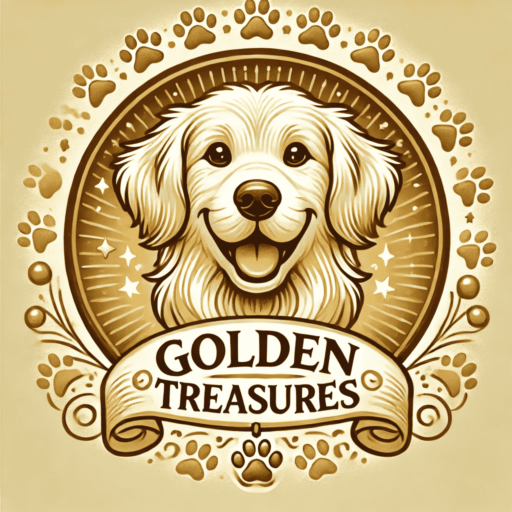
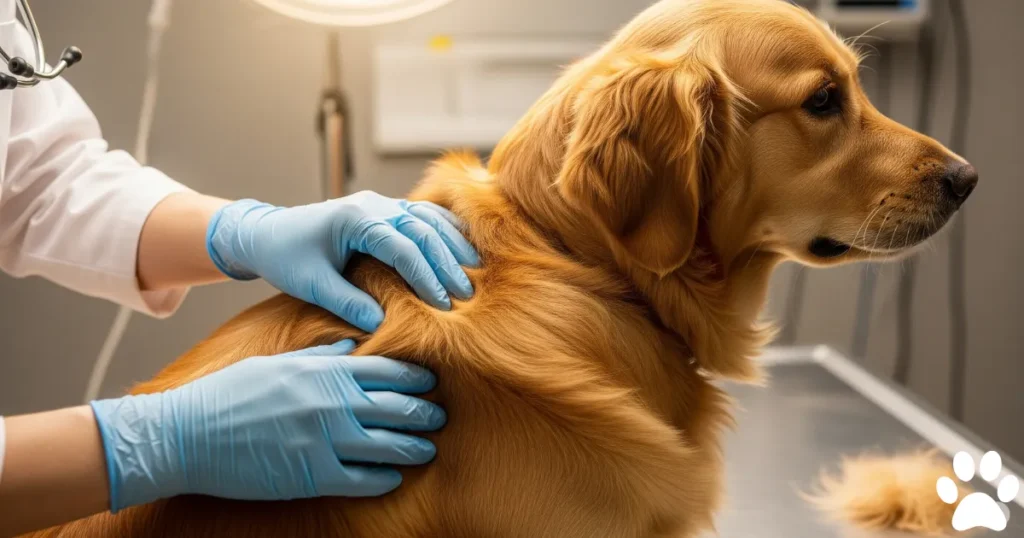
Links will be automatically removed from comments.